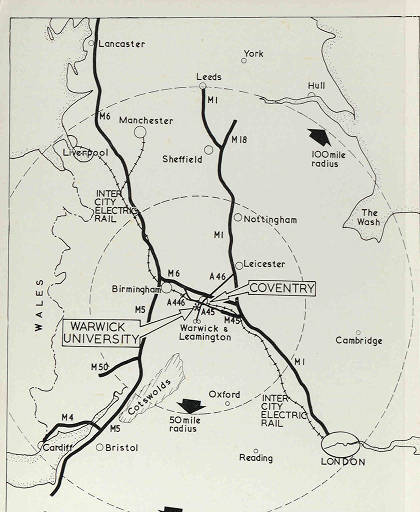University Development
Founding a University
In 1961 Prime Minister Harold Macmillan commissioned Lord Lionel Robbins, a famous economist, to produce a report on the state of higher education in the United Kingdom. The recommendation of the Robbins Report (1963) was that university places “should be available to all who are qualified by ability and attainment to pursue them” and during the 1960s seven new ‘Utopian Universities’ were built: at Sussex, York, Kent, Essex, East Anglia, Lancaster and Warwick. These universities were alternatively known as the 'plate-glass' universities (due to their distinctive architecture) or the 'Shakespearean' universities (as all of them, apart from East Anglia, had been characters in Shakespeare's plays).
Since the Second World War there had been intense discussion about establishing a new university in the Coventry area. Following negotiations with the University Grants Committee (UGC), the University of Warwick was established by Royal Charter in 1965 and was built in the countryside on the Coventry-Warwickshire border. It opened its doors to students in October 1965.
-
Michael Coker, Local Resident, on the area before the university was built
Some students and staff had begun work in 1964 and used houses on the Kenilworth Road or in huts or newly-finished buildings on the East Site (Gibbet Hill site).
-
Jean Norman, Administrator (1964-1965 and 1975-1999) on the Engineering Department in 1964, before the university opened
-
Ron Lockhart, Student (1965-1968) on first days at Warwick in 1965
University Development
The University continued to erect buildings on the main site: Rootes Social Building and the Library opened in 1966, Rootes Halls (Blocks A-L) in 1967 and Physics and the Maths Research Houses in 1969.
The distinctive design of many of the buildings attracted a lot of attention:
-
Arthur Lyons, Masters Student (1965-66) on Warwick's white tile-clad buildings
During this time, staff in the new academic departments began to pursue their research, often, at the start, with little specialist equipment. Undergraduate students arrived from October 1965. There was no graduation ceremony in 1966, but a small graduation ceremony for one-year Masters students took place in 1967. At this ceremony Jack Butterworth was officially installed as Vice-Chancellor of the university. The first full graduation ceremony took place in 1968 in Coventry Cathedral. All graduations took place here until the late 1980s.
At the time of the university's founding, Coventry was a centre of traditional manufacturing. It was particularly well-known for its car industry: the factories of Rover, Standard Triumph and Jaguar and smaller companies supporting the car industry employed thousands of workers in the city. By the late 1970s, however, much of this industry was in decline with a big impact on unemployment rates in the city.
-
Brendan Cassidy, Post and Portering Manager (1999-present) on Coventry in the 1960s
The University of Warwick sought to mitigate this decline in some way. The university was one of the first universities to open a science park on its premises in conjunction with Coventry City Council, Warwickshire County Council and Barclays Bank. The University of Warwick Science Park was designed to promote high-technology industries in a region hit hard by the decline of traditional manufacturing. It was opened in 1984 by Margaret Thatcher and is today owned completely by the university.
-
James Hunt, University Finance Officer (1993-2005) on the background to the building of the Science Park
By 1990, the university's own manufacturing group (Warwick Manufacturing Group) had become the largest of its kind in Europe, maintaining strong links with industry.
Through its activities, the University has sought to maintain a significant role in the economic and social life of the local region. It has considerable linkages with local business and enterprise through the Warwick Manufacturing Group and Business School, works closely with local schools and FE Colleges through the Institute of Education, widening participation and volunteer initiatives and has helped attract new investment to the Coventry area.

Map, University Prospectus, 1975 Modern Records Centre

Cryfield, early 1970s
Image courtesy of Mary Kenning
